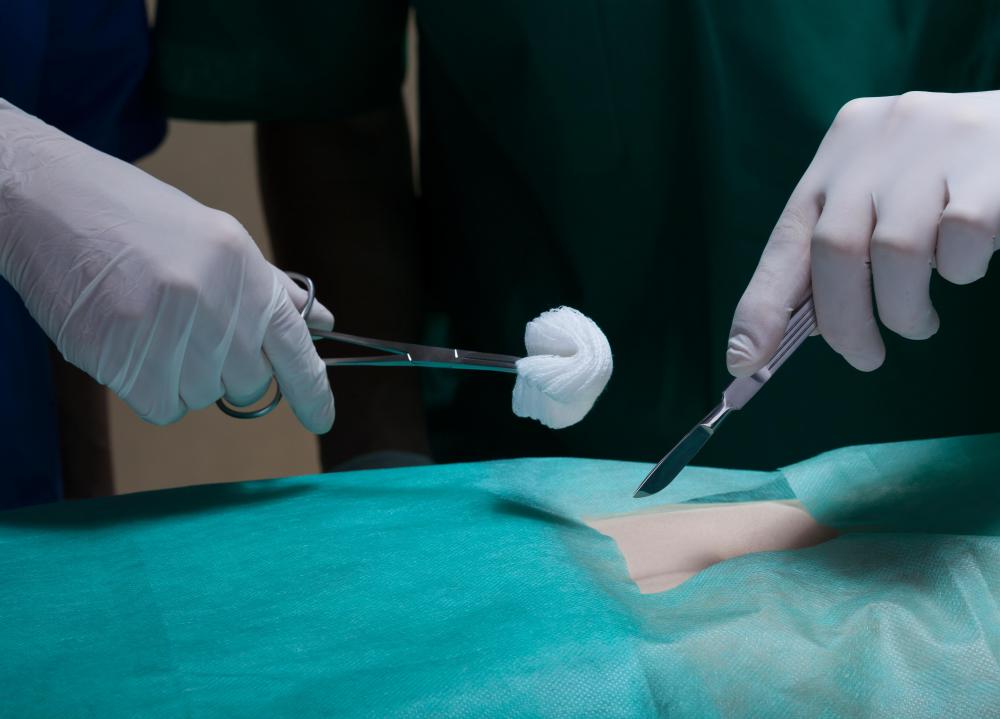At TheHealthBoard, we're committed to delivering accurate, trustworthy information. Our expert-authored content is rigorously fact-checked and sourced from credible authorities. Discover how we uphold the highest standards in providing you with reliable knowledge.
What is a Sump Drain?
A sump drain is a medical tool used to draw out fluids. This fluid-draining instrument is also known as a system of sump, or a suction pump, and consists of a small tube inside a large one. A sump drain can draw out fluids from a cavity through one tube while allowing air to enter the cavity to replace fluids. This movement of fluids is made possible through suction.
Suction is the physical force created by a difference in pressure. This allows fluids to be moved or sucked out. The air that enters the area is passed through an antibacterial filter which decreases the risk of contamination or infection. Non-filtered air flow is also an option.

The most common type of sump drain has a triple-lumen design. A lumen is the space inside a tube. This allows for maximal fluid removal with the simultaneous flow of air to the area. This air maintains pressure to help suction or force the fluids out. The third lumen can be used to irrigate the area with sterile saline or to infuse medication.
A sump drain typically is a handheld device resembling a pen. Sizes vary depending on the location of the procedure and the size of the patient. Some suction pumps are attached to an elongated tube to allow easy access to hard-to-reach places. The distal end of this drainage tool is often softened to reduce tissue necrosis upon insertion. Necrosis is death of the tissues.

A nasogastric sump drain, for example, is an extended-tube suction tool used to suck liquids out of the stomach by entry through the nasal area or nose. This draining procedure is used with small bowel obstructions, gastrointestinal bleeds or any condition where aspiration is a risk factor. Aspiration is the inhalation of fluids into the lungs.
Sump drains are utilized in a variety of surgical procedures where it is important to have fluid control. It can also be used to drain fluids and inject medication for wound care. These drains systems can also have an attachment to apply stitches or sutures to keep the drain intact when a chronic condition requires multiple draining.
The Penrose drain is a common feature of a sump drain. This long, flexible tube system allows for the passive drainage of fluids. It is typically used for surgical procedures which require drainage for closure of the wound or surgical incision. The tube can be tacked in place for drainage after the surgery is completed.
AS FEATURED ON:
AS FEATURED ON:












Discussion Comments
Sump is a low space that collects any undesirable liquids. I work with these drains. They are amazing and life saving.
So what is the actual connection between a sump drain and a basement sump drain, other than the obvious similarity in names.
Does the word "sump" mean something that I just missed out on, or is there some other reason why these two very disparate things have similar names?
Inquiring minds want to know!
@pharmchick78 -- I had exactly that response when my doctor told me I was going to get a sump drain after my surgery. I'm pretty sure I gave him bug eyes and said, "I think I've got one of those on my drain tile."
Of course after he explained it to me I was totally fine with the procedure and everything, but you have to admit that it's a weird name for a piece of medical equipment.
You have no idea how many people get confused when a doctor tells them that they're going to have a sump drain put in.
The response usually goes along the lines of "You're going to put a sump pump drain in me?!" or "Isn't that some kind of basement drain?"
Of course its easy to understand why people would get confused, and it totally makes sense for them to have that misunderstanding.
It does make for some great stories in the doctor's lounge though!
Post your comments